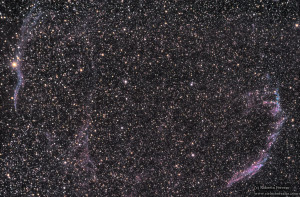Uno de los objetos más observados durante las noches de verano es prácticamente inaccesible al ojo del observador. Pero si ponemos a nuestro telescopio un filtro OIII y disponemos de más de 6″ de apertura la evanescente figura de los Velos aparecerá ante nuestros ojos.
Los segmentos más brillantes de la nebulosa se enumeran en el Nuevo Catálogo General con las designaciones de NGC 6960, 6979, 6992 y 6995, recibiendo sus partes nombres como el velo este, el velo oeste (o escoba de la bruja) y el triángulo de Pickering.
Se trata de un remanente de supernova que explotó hace 5000 u 8000 años y se encuentra a más de 1400 años luz de nosotros.
Fué todo un reto hacer entrar en el campo de la cámara todo el objeto. El guiado funcionó a la perfección así como las exposiciones. Tan solo las altas temperaturas veraniegas añadieron mucho ruido al a imagen y el hecho de no disponer de una cámara modificada (sin filtro IR) impidió sacar más detalles de este hermoso objeto.
TELESCOPIO / TELESCOPE: TS65Q APO
CÁMARA / CAMERA: Canon EOS 1000D
ACCESORIOS / ACCESSORIES:
AUTOGUIADO / AUTOGUIDE: QHY5+EZ60+PhdGuiding + Backyard EOS (Dithering)
EXP: 25×300″ (Darks, flats y offsets)
MALE: 4/5
SEEING: 4/5 (25ºC)
FECHA Y LUGAR / PLACE AND DATE: 7 de julio de 2013, San Martín de Montalbán, Toledo
PROCESADO / PROCESSING: DSS, Pixinsight LE, Photoshop
One of the objects most observed during summer nights is virtually inaccessible to the eye of the beholder. But if we put on our telescope an OIII filter and we have more than 6 » diameter the vanishing figure of the Veils appear before our eyes.
The brightest segments of the nebula are listed in the New General Catalog with the designation of NGC 6960, 6979, 6992 and 6995, receiving names like this, the western veil (or witch’s broom) and the triangle Pickering.
This is an exploded supernova remnant 5000 or 8000 years ago and is more than 1400 light years away.
It was quite a challenge to get into the field of the camera around the object. The guide and exposures worked perfectly . Only the high temperatures add much noise to the image and the fact of not having a modified camera (no IR filter) prevented out more about this beautiful object.


